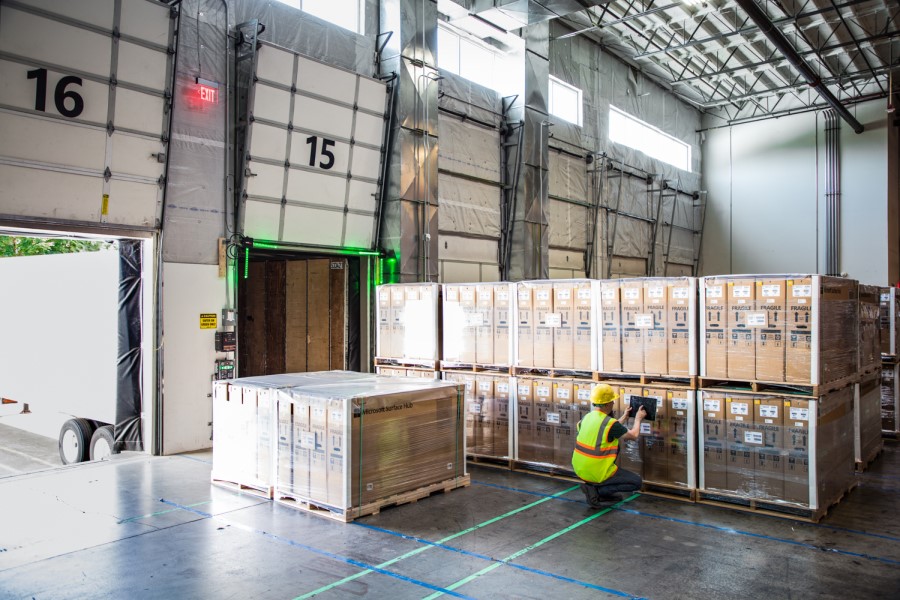Global retailers, manufacturers, and distributors continue to face the new normal of doing business today: economic volatility, unpredictable customer spending, and operational complexities. As we gear up for the holiday season, businesses that are agile and responsive will be poised to capture market demand and deliver an exceptional end-to-end customer experience. Adopting modern technology solutions can introduce agility to key processes overnight, and leaders should look across their supply chain functions to identify levers for maximum impact.
Supply chain technology leaders recognize that competitiveness—and in some cases, an organization’s survival—demands digital parity, if not leadership, so they now openly embrace exploratory IT investments.1
One of those levers is warehouse management, a market that IDC reports grew at a compound annual rate of 14 percent in 2023.2 By embracing modern, robotic, and AI-enhanced warehouse management solutions (WMS), organizations can drive meaningful results across the business in a relatively quick time-to-value.
In this post, we’ll explore why warehouse management solutions are needed and how Microsoft and Dynamics 365 enable customers to navigate ongoing disruptions, optimize inventory levels, and deliver on time with ease.

Dynamics 365 Supply Chain Management
Build a resilient supply chain
Navigate supply chain uncertainties with technology
While the early days of the COVID-19 pandemic are behind us, retailers and operators are still navigating the new normal, which includes:
- Growing labor constraints.
- Demand volatility.
- Multichannel distribution.
- Storage capacity challenges.
- Permeation of AI into core processes.
In the face of these challenges, there is an opportunity for businesses to embrace uncertainties with technology and maximize levers like distribution capacity, improved employee and warehouse productivity, and consistent operations during volatile times. Legacy enterprise resource planning (ERP) systems are often disjointed and lead to a delay in real-time insights and optimization.
What is a modern WMS?

A modern warehouse management system helps businesses manage and optimize key warehouse operations like inventory tracking and shipping coordination through an open and composable framework. It can integrate with multiple systems and platforms and helps support end-to-end business processes, from ERP to customer relationship management. For businesses that want to stay competitive in an ever-expanding fulfillment economy, a modern WMS meets those challenges with an agile, digitally connected solution that reduces costs through maximizing resources like employees, machinery and storage.2
Modern warehouse management solutions can help improve real-time visibility into inventory levels, provide the ability to automate and streamline operations, and drive greater efficiency across the organization.
Adopting a modern WMS can contribute to these outputs:
- Reduced costs through improved inventory turns and optimized storage space.
- Improved customer satisfaction via on-time and in-full delivery and improved fill rates.
- Business growth and agility to meet unexpected customer demand and product development.
- Automation and enhanced productivity to free up your employees’ time to focus on what’s next.
The benefits of a modern WMS
1. Reduced costs
Golden State Foods (GSF) is an industry leader that produces liquid products like sauces, dressings, and condiments for customers like McDonald’s and Chick-fil-A. With a 25 year-old legacy ERP system, GSF chose Dynamics 365 ERP solution’s Supply Chain Management and Finance to help create a modern, common platform with centralized reporting and more standardized processes to facilitate opening a new plant.
“We chose Dynamics 365 because we need modern technology that will evolve with us.”
–Carol Fawcett: Corporate Vice President and Chief Information Officer, GSF
With Dynamics 365 Supply Chain Management, GSF’s warehouse management processes were completely modernized. Dynamics 365 is being used to receive, put away, and consume inventory for production; report inventory as finished; store it in finished goods warehouses; and select it for shipment for customer orders. It prints standard barcode labels that are used at customers’ distribution centers for fast and accurate traceability—a considerable improvement from previous processes. This end-to-end visibility helps GSF operations managers improve inventory turns and make better decisions about production restraints and forecasting. With improved forecasting, GSF can reduce waste, optimize inventory, and increase its efficiency across its plants.
2. Improved customer satisfaction
Bedrosians Tile & Stone is one of the largest porcelain tile and stone importers and distributors in the United States, with 40 retail locations worldwide. It’s 30 year-old legacy ERP system impacted demand planning and forecasting, which was critical for Bedrosians’ massive 10,000-item inventory. Without accurate demand planning and forecasting, Bedrosians was reactive and vulnerable to market whims.

Like many retailers, Bedrosians saw customer demand skyrocket during the COVID-19 pandemic. Annual spending on home improvements grew, but without accurate demand forecasting, Bedrosians struggled to find that “just right” inventory on hand formula, often finding itself understocked or overstocked. With lead times as long as six months or more, the need to have accurate inventory levels—and visibility into them—couldn’t be more important.
Bedrosians’ legacy ERP impacted its ability to optimize inventory placement and as such, the company was at risk of promising products they couldn’t deliver or losing sales opportunities while inventory was in transit. Bedrosians chose Dynamics 365 ERP solutions to help optimize financial, inventory, purchasing, and planning capabilities to better streamline the movement of their globally sourced inventory. What used to be a manual guessing game has turned into an automated, scientific forecast based on historical data and industry trends. This ensures Bedrosians can capitalize on sales opportunities, despite months-long lead times, and deliver an on-time and in-full customer experience.
“Implementing Dynamics 365 has been a game-changer for our business. It has improved our operation and financial management. Real-time visibility, optimized procurement, and streamlined order processing has resulted in increased sales, improved margins, and a more efficient supply chain and positioned us for sustained growth in a competitive market.”
–Nirbhay Gupta: CIO, Bedrosians Tile & Stone
3. Business growth and agility
Barnas Hus is Norway’s leading children and baby products retailer, with both e-commerce and 28 physical stores. Working with a Microsoft partner, KPMG, Barnas Hus set out to face its supply chain challenges that were hindering its business growth, such as lack of visibility and inconsistent accuracy in its legacy ERP system. Barnas Hus embraced a modern, cloud-powered platform enabled by Dynamics 365. This technology-focused improvement helped the company transform its warehouse management, inventory control, production planning, and more—setting Barnas Hus up to meet growing customer demand.
Once they had made the shift, Barnas Hus opened a new state-of-the-art warehouse that utilizes autonomous robotics to accurately pick, sustainably pack, and trace every product. The modern warehouse management system improved inventory visibility and freed up employees to spend time with customers. The best part? The ease of implementation led to a quick time to demonstrate value and Barnas Hus saw its biggest month ever in revenue.
See how Barnas Hus embraced robotics with KPMG and Dynamics 365.
4. Automation and enhanced productivity

Michael Hill is a leading jeweler based in Australia with operations in New Zealand, Canada, and the United States. When the pandemic hit, its 300 stores were facing temporary closures and the company confronted logistic complications that forced expensive, indirect, and inefficient shipments to its customers worldwide. Michael Hill’s legacy ERP system was inflexible and lacked visibility and accuracy.
The international jeweler moved quickly to avoid harm to its business and its brand. It rapidly deployed Dynamics 365 and almost immediately began providing increased visibility into inventory availability across its supply chain. This gave Michael Hill the ability to treat each of its stores as a warehouse location, which seamlessly allowed customers to order items online with the option to pick up at the site of their choice or ship direct from that location. It also vastly reduced the manual labor previously required from Michael Hill employees to ensure fulfillment.
“We use the ship-from-store capability in Dynamics 365 to fulfill demand from many locations, rather than requiring human intervention whenever stock is transferred. That helps us reduce how many hops it takes to put a piece into the hands of the customers, and that’s our end game—a better experience.”
–Matt Keays: Chief Information Officer, Michael Hill
By implementing Dynamics 365 as its warehouse management system, Michael Hill was able to deliver agile flow solutions that freed up its employees to focus on more strategic initiatives such as loyalty programs and trialing new fulfillment models.
Learn more about Dynamics 365 solutions
To compete and thrive in market conditions today, organizations should look to adopt modern warehouse management solutions to better prepare for uncertainty, increased demand, and disruptive conditions. While legacy ERP systems are complex, Microsoft partners and Dynamics 365 solutions provide quick time-to-value and provide the agility and automation required for growth.
Explore a free guided tour of Dynamics 365 Intelligent Order Management.
Learn more about Dynamics 365 Supply Chain Management.
Footnotes
1Gartner SC 2023 Hype Cycle for Supply Chain Execution Technologies, 2023.
GARTNER is a registered trademark and service mark of Gartner, Inc. and/or its affiliates in the U.S. and internationally, and HYPE CYCLE is a registered trademark of Gartner, Inc. and/or its affiliates and are used herein with permission. All rights reserved.
2Source: IDC TechBrief, Warehouse Execution Systems, Document number:# US51050623, August 2023.
We’re always looking for feedback and would like to hear from you. Please head to the Dynamics 365 Community to start a discussion, ask questions, and tell us what you think!






